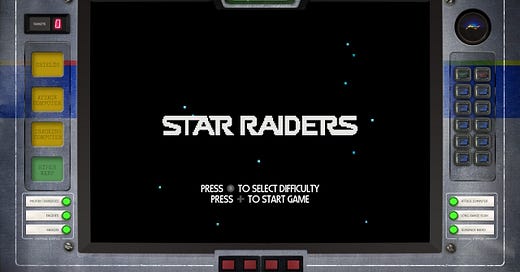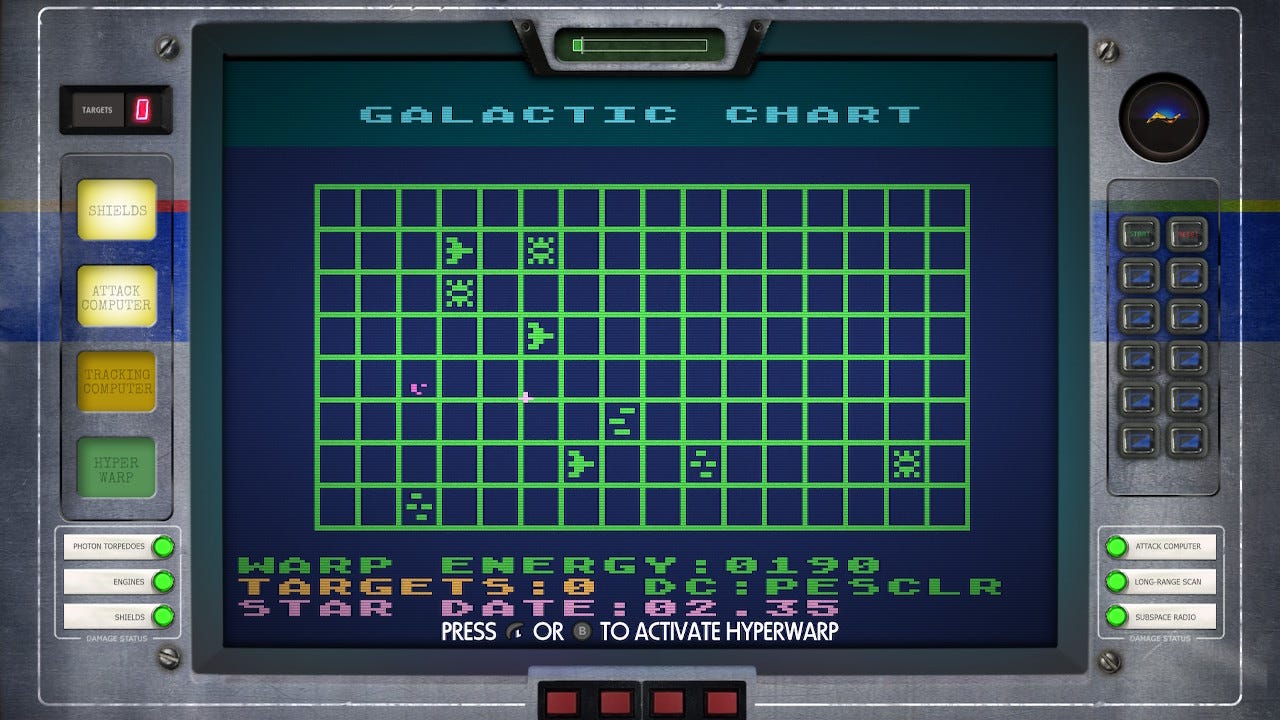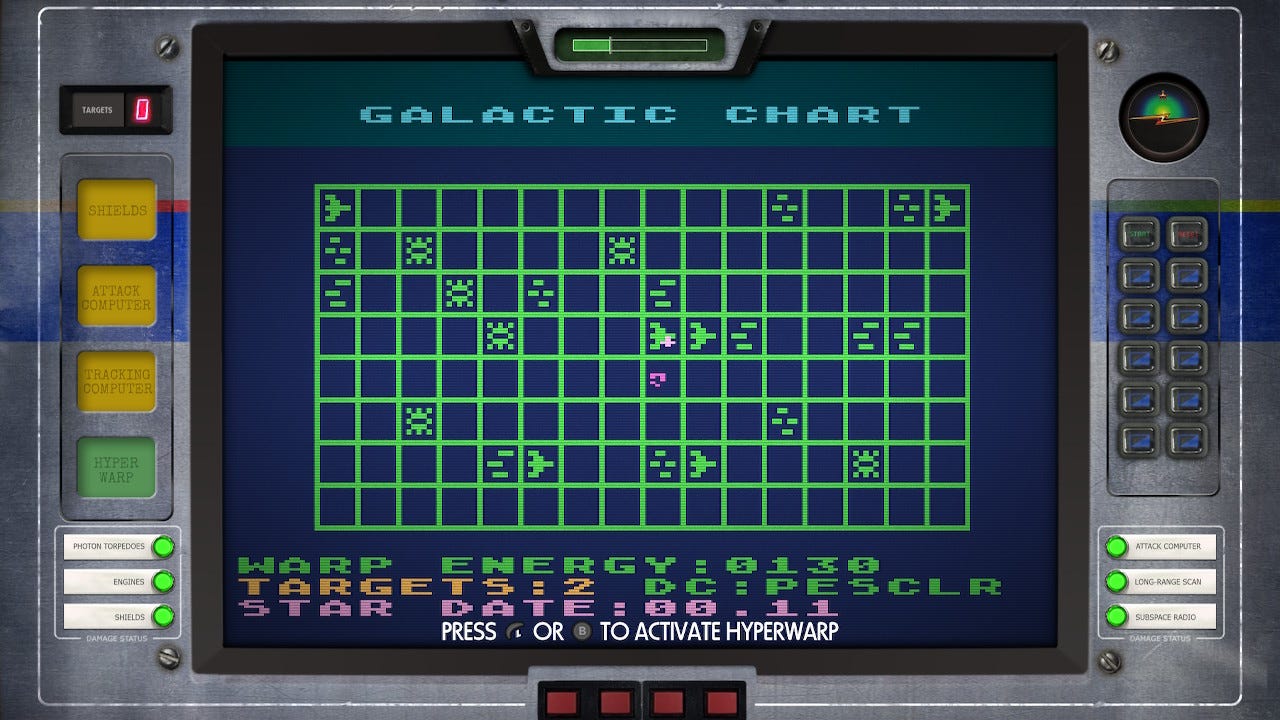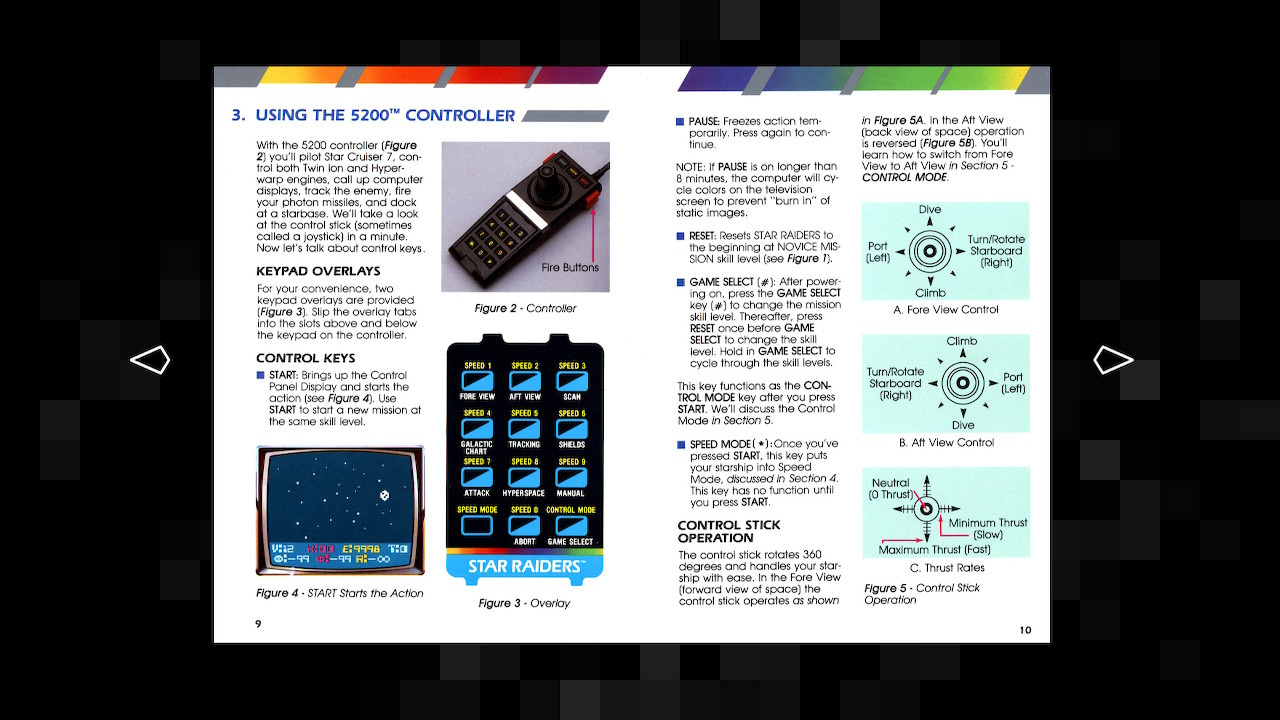Past meets present: Star Raiders
Digital Eclipse has breathed new life into the classic Atari title that launched a genre.
This column is “Past meets present,” the aim of which is to look back at game franchises and games that are in the news and topical again thanks to a sequel, a remaster, a re-release, and so on. Previous entries in this series can be found through this link.
Atari’s platforms often hosted games that would serve as inspiration for future titles made by other companies in later years — for instance, the “action-adventure” genre partly sprung forth from a 1980 Atari release, appropriately named Adventure — but that could also end up their legacy, at least to people who don’t fully immerse themselves in this sort of thing. They were fun for the time, they were ambitious, they were inspired, but they were also developed when there were more limitations both in tech and in accumulated knowledge. Nintendo’s The Legend of Zelda gets so much more credit for pushing forth the action-adventure genre because it took the ideas of Adventure and combined them with other elements, such as those found within The Tower of Druaga, to create something new, something exciting, something that hadn’t been seen before in the form it was in. And the rest of the industry reacted by saying, with their own developments, that this was a thing there should be more of, and more often. (And now we have Breath of the Wild, and Elden Ring, and… you get the picture.)
The Legend of Zelda’s major advantage over Adventure wasn’t just that it was on the more powerful NES (and Famicom Disk System in Japan) instead of the Atari 2600. It’s that Adventure already existed, as did far more video games than did in 1980 when it was developed — video games that could influence Nintendo, video games Nintendo themselves had made and learned from, and then apply that knowledge to the making of Zelda. So, for many, Adventure becomes a footnote, if it’s known at all, while the first Zelda becomes the start of something in their mind. Not everyone is going to be convinced that the game where you’re a large pixel square with a sword somewhere nearby the square is worth checking out in 2023, you know? Zelda’s past is a bit easier to conceptualize. Link is right there, some of his foes from his inaugural adventure remain foes in his latest one, too, and more importantly, look familiar.
Obviously, video games didn’t start with Nintendo, but they were right there at the moment where playing them in your living room took off in a way that said, plainly and confidently, that this was not a fad, that the industry was not collapsing in on itself as it looked like it had during Atari’s stewardship of it. It’s pretty easy to see, between the changes in tech that made for more games that would appeal to more people and exist in places besides the arcade, and the closer relation between the games of today and the games of 1986 or whatever, how Atari’s own influence can sometimes slip through the cracks, how the education on where the games that influenced the games you do know and love from that time period can be lacking.
Anyway, this is all a long way of saying that another 1980 Atari release, Star Raiders, is a bit different than those games, and that we’re lucky to have Digital Eclipse around in the present to remind us of the gaps in our knowledge, but more on that second part in a bit. Star Raiders is its own Zelda, in the sense that it was able to build more on what came before to create something new, and that something — the 3D space combat simulator — took off from there, Star Raiders’ influence on future titles within the genre evident every time you fired one up, no matter how far removed from 1980 you got. Really, the only issue with it in the present was that the tech lagged behind the ambition of the game, but that’s now a solved problem: again, more on Digital Eclipse in a bit.
Star Raiders released for Atari 8-bit computers in 1980, and was a revelation. Programmed by Doug Neubauer, it was heavily influenced by the sci-fi of the day. Neubauer, per Retro Gamer (issue no. 79) wanted an action game that had a clear story behind it, to marry the narrative of text-based games like the 1971 Star Trek mainframe title with the excitement of something like 1978’s Battlestar Galactica television series or the interstellar dogfights of Star Wars. The manual for Star Raiders goes into detail about the war that’s raging against the Cylon forces — sorry, the Zylon forces — and how you have to go about piloting your space fighter to save space stations and your side of the galaxy.
And the game does deliver what it says it will: it feels (mostly) fast-paced, there’s plenty of action to be had, it does a convincing job of creating what feels like a 3D space to fly through even all the way back in 1980, and thanks to subspace radio messages received to update you on the goings on of the systems you’re flying around, you do feel like you’re in the midst of an ongoing war. There actually is a narrative at play here, and you can feel it working on you as you play, with stakes rising the longer you play, the fewer space stations remain for you to defend as they’re taken out by your opponents.
Star Raiders is a truly difficult game on its higher difficulty levels. On “Novice,” the lowest setting, there’s not much to it. You stare out the window of your ship’s cockpit at the vastness of space around you, stars and the occasional asteroid (that you’re not going to want to have crash into you) in the background. You open up your galactic chart to see where the space stations you’re supposed to protect are, and where various enemy fighter wings are currently located. You need to defeat these wings, which are made up of a few to oh no that’s too many ships at once, before they can surround and destroy the space stations. This is important for two reasons: one, the game ends if everything you’re supposed to protect is blown up, and two, if you end up damaged in combat, the only way to repair your ship is to dock with one of these stations. If you can’t get to a station because your engines or targeting or ability to see what’s where on scanners is gone, well. Good luck stopping that full-scale invasion.
On Novice, though, there aren’t many enemies, and they aren’t really moving. This is just to get you into the basics of Star Raiders, to give you space to learn how the systems work, how to move around the galaxy and within the sector (the star date, per the game’s parlance) that you’re in, how to fight, how to speed up and slow down and move and use your various computers and scanners. And you will need all of this early education, because as soon as you bump things even up one level to “Pilot,” the game changes, and is also on. There are far more foes to defeat, and they will attack you more aggressively and with more damaging hits. They’ll start strategizing their movements and coming after your space stations to surround them, ensuring that you won’t have time to fend them all off: in this situation, the manual actually recommends that you yourself blow up the station, in order to keep the Zylon forces from building more ships for themselves out of the wreckage. Star Raiders is a game where everything you do takes time, and time is the thing you do not have much of.
There are two difficulties beyond Pilot — “Warrior” and “Commander” the others — and they are brutal. That’s not a complaint, mind, but check out the difference in the galactic map between the lowest difficulty and the highest. Here’s Novice:
And here’s Commander:
The fighter ships are smaller wings with 2-3 enemy ships in them, while the groups of three and four small lines are larger wings that likely have some higher-end foes within them, as well. The rest of those spaces, the ones that look like a spaceship with a horizontal window in the face of them, are your stations that you need to protect. There are just a few to protect on Novice, with few enemies to go after them, but on Commander? Well, you probably want to pick the station you’re fine with losing before you pick the one you want to save first.
Difficulty is about more than just the number of enemies. You also have to manage your energy reserves: every action consumes energy. Turn on your shields? Energy is consumed. Fire your photon torpedoes? Energy is consumed with every shot. Turning on your engines will use energy, going into hyperspeed will use up a ton of energy, more depending on the distance. To refill your energy, you need to dock with a space station, which means finding it on the galactic chart, flying there, then discovering its location within the sector. Target it with your attack computer, and that’ll put you in “orbit” of it, which will be the signal for a repair ship to come out to fix you up and refill your energy. On Novice, you might need an energy refill. Above that difficulty, you’ll need to visit to repair broken systems, like shields, weapons, engines, and scanners, as destroying the Zylon fleet is going to be tough to pull off without you at 100 percent.
The manual suggests you don’t just fire your torpedoes until you hit something, consuming a bunch of energy in the process, and instead let your computer target a foe first — the hit rate and chance of killing them this way is much higher — but that’s more of a to each their own situation. Or maybe we’re all just inherently a little more accurate in 2023 than when the genre was first being introduced over 40 years ago.
Since Star Raiders released on computers before hitting consoles, there are plenty of different buttons for you to press. Activate your shields to avoid taking damage that’ll immediately kill you with one button. Turn on your attack computer with another. Turn on a targeting computer that helps you track enemy ships and which direction they’re in with another. Jump to warp speed with the press of a button, with no destination in mind besides escaping the one you’re in, with another. Move through space at a non-warp, adjustable speed, and slow down, with another pair. Fire proton torpedoes with yet another button. There are a lot of buttons, and in the port to consoles, Atari kept them intact thanks to the use of their keypad controller. The manual explains how to use them all in detail, which, as a person who recently wrote up the various inputs for another space combat simulator, Freespace, onto post-it notes and stuck them underneath my monitor, is obviously helpful.
While the Atari 2600 port of Star Raiders was disappointing — that system didn’t have nearly the horsepower of Atari’s arcade or computer platforms, with its appeal being more that it was living room entertainment for the whole family — the Atari 5200 port was more in line with that of the 8-bit computer versions. Even with the 5200 being more powerful than the 2600, however, Star Raiders still remained just a little more ambitious than the tech could handle. Every time you blow something up, the ensuing explosion slows the game down to a bullet time-esque crawl. Here’s what the original Atari 5200 version of Star Raiders played like after blowing up an asteroid and enemy ships:
Remember, this is without any in-game music, and with sound effects only playing when you’re firing a shot or after an explosion. The ship itself isn’t even traveling through space here, but is staying put, firing off shots: and yet, everything comes close to a complete stop. And it’s like this for every single explosion.
However, this is where Digital Eclipse comes in. For Atari 50, the anniversary collection released in 2022, the preservation-minded developer kept the original versions of the many, many games included, but including the option of playing a spruced up version that could handle the ambition of something like Star Raiders. In addition to the “Original” mode, there’s also “Enhanced” and “Enhanced and Overclocked,” which not only introduce useful information in the letterboxing of the screen, but make sure that none of this slowdown occurs while you play.
Look how seamless that all is! Star Raiders suddenly feels, other than the 1983 graphical stylings, very modern to play. Which only serves to enhance the idea that Star Raiders was a complete idea that’s been iterated on for decades now, at the heart of the genre the entire time.
Each play of Star Raiders is a one-off. There is no default arrangement of enemy forces on the various difficulties: you start it up, it generates a “scenario” involving the rules of the difficulty level, and you’re off. You can play again and again and have some easier initial setups, and some more difficult, but it’s always going to be a challenge even if you know what you’re doing on the higher difficulties. All it takes is one botched dodge of a proton torpedo or failure to counter it with your own, and then you’ve maybe damaged a key system. You know how in racing games with pit crews, you’re always worried you’re immediately out of the race if you actually have to utilize their services? It’s a lot like that, and everything can change if you suddenly lose your shields or primary engine or radio or even your weapons system. It makes Star Raiders a compelling, deep experience, even all these decades later. It just looks a bit ancient, but the feel is still right.
The influence of Star Raiders was massive, which, yeah. It kickstarted an entire genre! Elite (1984), Star Luster (1984), and Wing Commander (1990) all owe a debt to Star Raiders. The complexity of games like Freespace and the various X-Wing titles from the 90s, too. Even just technologically speaking, this first-person, 3D-esque presentation that was actually a two-dimensional plane, with sprites moving in and out to show distance? Wolfenstein 3D was still using that same trick over a decade later, which in turn led to DOOM and the “DOOM clones” that would dominate the market before “true” 3D games arrived on the scene. And these games all eventually led to space combat from a third-person view, as well, once the tech was able to render a ship instead of just a cockpit: you really can’t discount the enormity of what Star Raiders helped to create down the line.
And now, since it’s included in Atari 50, you can play it in its definitive form, and even read a full scan of the manual before you do so. Digital Eclipse really outdid themselves here, with a collection full of games that are worth playing, worth learning about, or both. Star Raiders fits into the last of those camps, easy, thanks in part to the developer’s decision to update it without fundamentally changing what it was.
This newsletter is free for anyone to read, but if you’d like to support my ability to continue writing, you can become a Patreon supporter, or donate to my Ko-fi to fund future game coverage at Retro XP.








Fascinating as always to read about the forgotten ancestors and progenitors of familiar gaming models. It's great that they were able to give it that update for the anniversary.